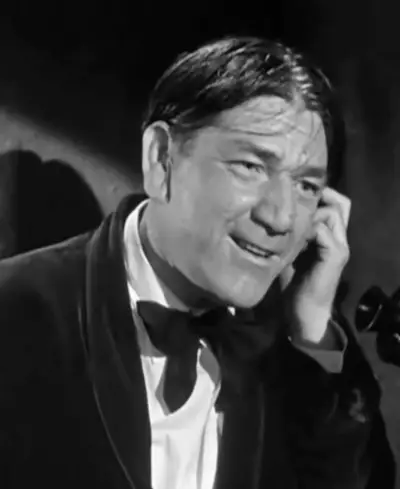Shemp Howard
(1895 - 1955)
 |
Samuel Horwitz, known professionally as Shemp Howard, was an American actor and comedian. He is best known for his role as the third stooge in the Three Stooges, a role he first portrayed at the beginning of the act (1923–1932) while the act was still known as "Ted Healy and his Stooges", and again from 1946 until his death in 1955. Between his times with the Stooges, Shemp had a successful film career as a solo comedian.
Shemp was born in Manhattan, New York on March 11, 1895, and raised in Brooklyn. Shemp's brother, Moe Howard, started in showbusiness as a youngster, on stage and in films. By 1922, Moe had teamed up with boyhood-friend-turned-vaudeville star Ted Healy in a "roughhouse" act. One day Moe spotted his brother Shemp in the audience, and yelled at him from the stage. Quick-witted Shemp yelled right back, and walked onto the stage. From then on he was part of the act, usually known as "Ted Healy and His Stooges". Healy's original stooges were the Howard brothers, with Larry Fine joining in March 1925.
After a disagreement with Healy in August 1930, Moe, Larry and Shemp left to launch their own act, "Howard, Fine & Howard," and joined the RKO vaudeville circuit. The act premiered at Los Angeles' Paramount Theatre on August 28, 1930. Moe, Larry and Shemp continued until July 1932, when Ted Healy approached them to team up again for the Shuberts' Broadway revue "Passing Show of 1932," and they readily accepted the offer. In spite of any differences, an association with the nationally-known Ted Healy provided opportunities the three comics were not achieving on their own.
On August 16, 1932, in a contract dispute, Healy walked out on the Shuberts' revue during rehearsals. Following this, three days later Shemp left Healy's act to remain with "Passing Show," which closed in September during roadshow performances and after bad reviews in Detroit and Cincinnati. Shemp regrouped to form his own act and played on the road for a few months, before settling in New York City.
Shemp Howard, like many New York-based performers, found work at the Vitaphone studio in Brooklyn. Originally playing bit roles in Vitaphone's Roscoe Arbuckle comedies, showing off his goofy appearance, he was entrusted with speaking roles and supporting parts almost immediately. Shemp would seldom stick to the script, and would liven up a scene with ad-libbed incidental dialogue or wisecracks. This became a trademark of his performances. In late 1935, Vitaphone was licensed to produce short comedies based on the "Joe Palooka" comic strip. Shemp was cast as "Knobby Walsh," and though only a supporting character became the comic focus of the series, with Johnny Berkes and Lee Weber as his foils. He costarred in the first seven shorts, released during 1936 and 1937; nine were produced altogether, with the last two done after Shemp's departure from Vitaphone for greener pastures on the West Coast.
Away from Vitaphone he attempted, unsuccessfully, to lead his own group of "stooges" in the Van Beuren musical comedy short The Knife of the Party. Shemp's solo career was otherwise successful. He followed his brothers' lead, moved to the West Coast in 1937 and landed supporting-actor roles at several studios, predominantly at Columbia Pictures and Universal Studios. Shemp worked exclusively at Universal from August 1940 to August 1943.
Shemp was given his own starring series in 1944, and was working for Columbia in this capacity when his brother Curly was felled by a debilitating stroke on May 6, 1946. Shemp replaced Curly in Columbia's popular Stooge shorts, knowing that Moe and Larry would be out of work if he refused. He rejoined the Stooges at first on only a temporary basis until Curly recovered, but as Curly's condition worsened it became apparent that Shemp's association with the Stooges would be permanent.
Shemp's role as the third Stooge was much different from Curly's. While he could still roll with the punches in response to Moe's slapstick abuse, he was more of a laid-back dimwit as opposed to Curly's energetic man-child persona. Shemp appeared with Moe and Larry in 73 short subjects—or 77, counting four that were made after Shemp's death using stock footage—and in the feature film Gold Raiders (1951).
Shemp suffered a massive heart attack and died in a cab on the way back from watching a boxing match on November 22, 1955. He was 60 years old.
Sources: Shemp Howard,
Wikipedia;
Shemp Howard,
www.threestooges.com.


